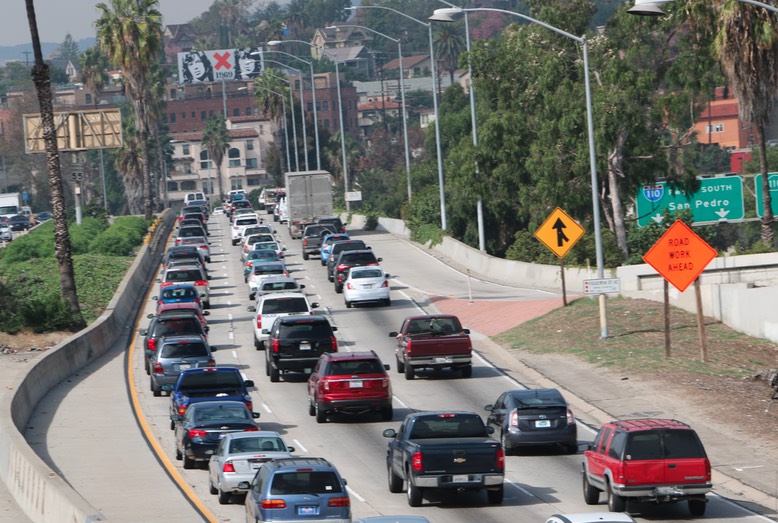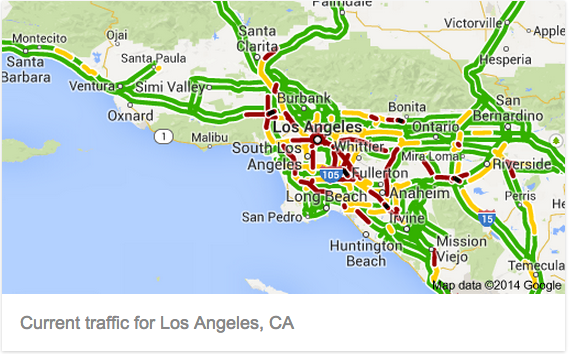In Los Angeles traffic is just part of the life, right? A cliche that has been brow beaten into us by countless photographs, internet rants, movie car chases and real-life suspect pursuits broadcast via helicopter on the 5pm news. But the cliche is one thing. The reality and data behind that cliche is quite another.
A census report of data collected from 2005-2010 showed that the average commute time for Los Angeles County residents was 29.4 minutes, 15% higher than the national average. Moreover 11.9% of those commuters had a travel time that exceeded one hour. And for those of us who commute in the city on a daily basis this estimate probably seems like it severely underestimates the carnage of our experience.

The good news / bad news situation about the L.A. traffic scene is that while there are certain pain-in-ass realties we all have to deal with, there are steps you can take to ameliorate some of the burden. Personally, I am of the philosophy that everything can be improved, so even if it’s just a matter of taking a super sucky thing and making it just a little bit less sucky, then by all means let’s make it happen.
To that end, I collected my thoughts, did a little research, and listed out six thing you ought to be aware of when considering traversing the Los Angeles roadways on a daily basis, whether you’re a prospective resident/commuter or have been battling on the 405 for decades.
Here’s the list:
1. Know Your Commute
First rule of commuting in Los Angeles: Always assume there will be traffic. The second rule of commuting in Los Angeles? ALWAYS assume there will be traffic.
Since you can live and die by that eternal maxim, the first thing to do is to know where the trouble spots are. For starters, INRIX does a study every year to show where the most congested corridors in the nation are. Six of the top 20 worst corridors resided in Los Angeles, headlined by the SB 405 from Nordoff St. to Mulholland Dr. If possible, avoid or reroute.
Try to evaluate your commute time from an analytical point of view. Study the Siglalert patterns at different times of the day, and always utilize Google Maps route time estimator to gauge average drive times then compare them to your actual drive times.
At the end of the day there is no excuse for real world experience so as you begin to undertake your commute on a daily basis, try to observe where the trouble sports, where pressure release valves might be, and how you might avoid the whole mess altogether. Trial and error will yield results over time, but leave room for some frustration in between when your “shortcut” ends up costing you another 30 minutes in the car.
2. Live Closer to Where You Work
This one seems obvious, but I think people (young singles especially) underestimate how the grind of a commute can impact one’s quality of life. According to a study by the Gallup-Healthways Well-Being Index, 40% of commuters who traveler more than 3 hours per day tend to worry for the majority of the working day. Moreover, longer commutes are associated with increased tiredness and lower amounts of happiness.
So what’s the single most drastic thing you can affect this happiness imperative? Geography. If you live closer to where you work, you’re going to be less worried and less stressed, and in all likelihood, a much happier individual.
That said, I realize this is not an option for a vast majority of commuters, as there are many other factors (relationships, income, family etc…) that are part of the equation of where we live. However, for those who do have flexibility (I’m looking at you, single professionals in your mid-twenties) then realize that you should be taking this important factor into consideration.
3. Use Public Transit
The urban sprawl of Los Angeles and lack of available Metro line access means the light rail system won’t be able to benefit everyone. In fact, if don’t live near a metro line station and your work isn’t near a station, then you’ll either have to park/ride or utilize the bus, either of which will add minutes to your overall commute time. Not necessarily the most thought out system
The upside here is that if you do choose to utilize public transit rather than sit in your car, you’ll have the opportunity to leverage your time focusing on tasks that provide utility or pleasure to your life as a whole (see point #6 on this list).
The L.A. Metro has a ‘trip planner’ tool that they use, but that doesn’t take into account walk times, so my preference when planning bus/metro trips is always to just go straight to Google Maps.

4. Leverage Technology
It kind of goes without saying, but you’d be surprised how much guidance some folks need on this topic.
I mentioned Sigalert and Google Maps already, but there are a hosts of ways to gain insights from technology on what
For radio, KNX 1070 AM probably offers the most robust traffic updates, doing the highlights about every 10 minutes or so. And as far as apps go, I’m personally a big fan of Waze.
In my opinion Waze is (currently) the best crowd-sourced traffic updating app available. The platform is generally fairly easy to follow and integrates nicely if you use blue-tooth tech in your car. The app calculates fastest route times using available information and will adapt over time to preferred routes.
As you’re driving it will also inform you about upcoming traffic congestion, police presence, accidents, and other traffic related insights. And one of the best thing’s about Waze is that the more people that use it, the more valuable it becomes (yay crowdsourcing).
advertisements
Fair warning though: Don’t be one of those idiots who is constantly playing with Waze while you’re driving and diverting your attention from the road. Try to configure Waze before you get going as a way to game plan your commute, then let it inform your driving decisions as you execute the plan.
5. Commute at Non-Peak Traffic Times
10:30 – 7:30 is better than 9:00 – 6:00.
If your job is amenable to you choosing off-traffic hours you might be able to trim your commute time 5-10 minutes each way per day. That’s potentially 100 minutes per week, and roughly 80 hours a year you might be able to save.
Imagine what you could do with that time!
That said, not everyone’s boss is going to allow this flexibility, but it never hurts to ask. And hey, you can always leverage the argument about your stress level and productivity by allowing you to commute at non-peak traffic hours. It’s science!
6. Value Your Time
At the end of the day, there are certain routes, certain jobs and certain circumstances that mean a commuter will have no choice but to simply buck up and slog through the molasses of the L.A. roadways. But even if that’s the case, don’t let your time in the tin can define who you are. Instead, define for yourself what that time will mean to you.
Listen to a podcasts
Learn a language.
Make a phone call.
advertisements
Explore new music.
Try to find (driver safe) activities that enrich your existence rather than focusing on the expletive mutterings and anger tinged sighs that may predominate your current commuting ritual. And even if it doesn’t solve all your parking-lot-on-the-freeway infused rage issues, at least you can make the drive time suck just a little bit less.
In Conclusion
There is no silver bullet here, and until public transit becomes more widely accessible and/or mechanized A.I. cars are able to calculate seamless routes for us then it seems we’re all in this mess together.
The best you can do is plan ahead, leverage the information you have at hand, and if all else fails, try to make the most of the time you’re stuck waiting in gridlock.
See you on the battlefield.
advertisements
